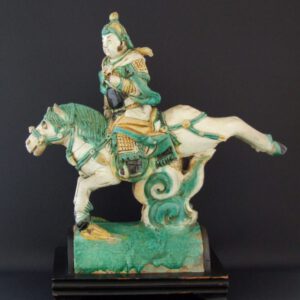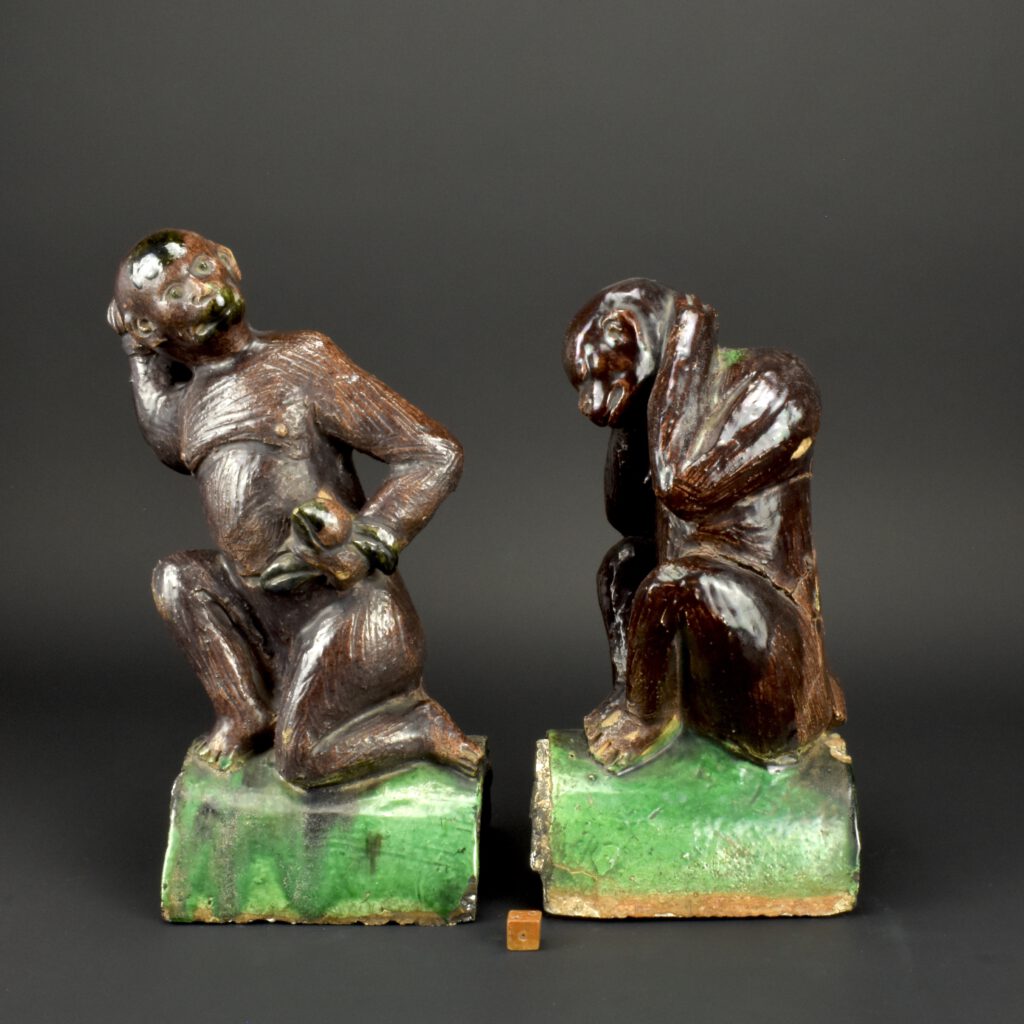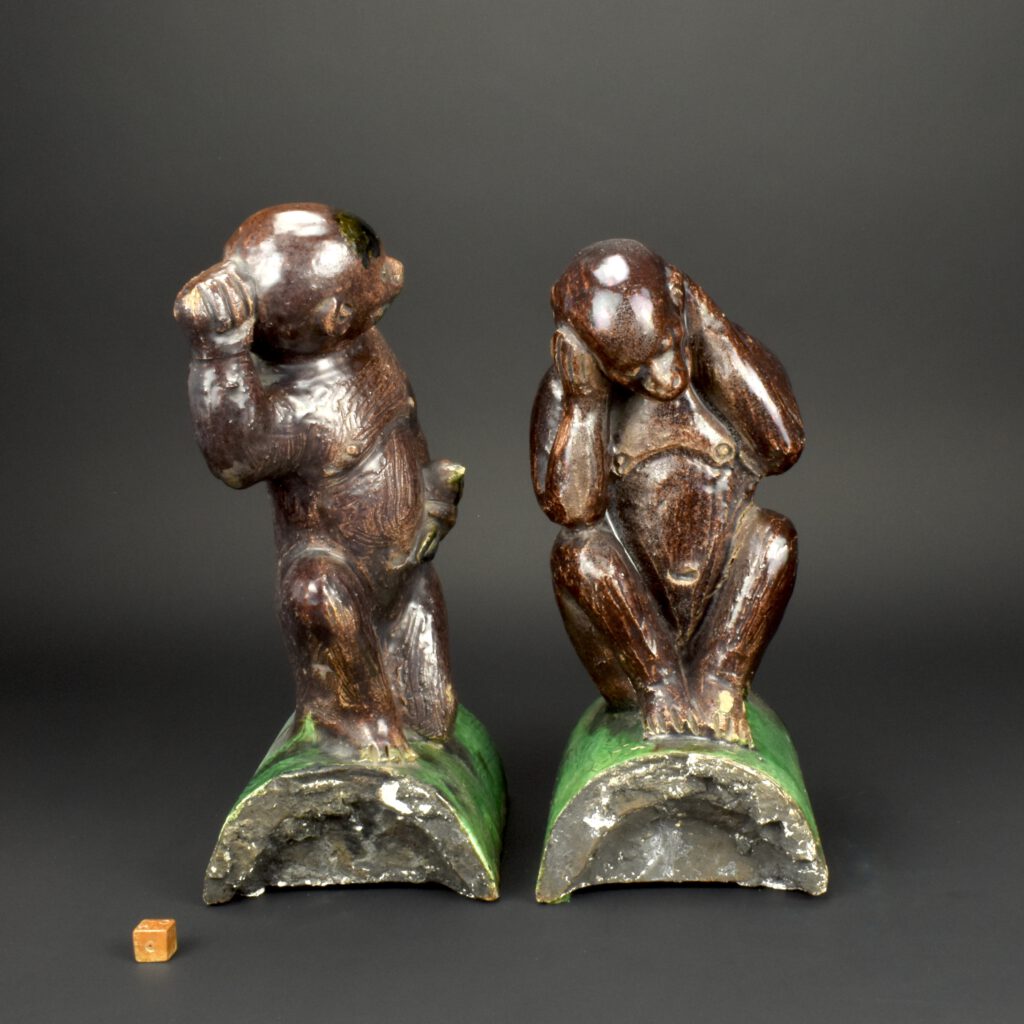
A Pair of Rare Monkey Form Ming Earthenware Ridge Tiles
A Pair of Rare Monkey Form Ming Earthenware Ridge Tiles, Probably Shanxi Province c.1500 – 1620. This rare pair of Ming tile-works pottery monkeys comes from the collection of Mrs. S. K. De Forest. They were sold with other pieces from her collection in New York on January 11th, 1936, see ‘Provenance’. These monkeys are a rare depiction of the animal among Ming architectural pottery. There is allot of detailed hand work to the bodies, for example the depiction of the fur. It is interesting to see that Ming roof tiles, which were high up on the building, were often very detailed and even inscribed. Clearly these details could not be seen from below, but that wasn’t really the point. The symbolic presence of these Ming ridge tiles was what was important. According to traditional Chinese belief, roofs are platforms of communication between the words of the living and spirit realms. Consequently, they were decorated to ward off evil and to act as a magnet for blessings and good fortune. The Chinese perceives the monkey as a lucky and a smart animal. When the Chinese refer to someone as ‘a monkey’, they mean to say that he or she is extremely sly or cunning. The homonym hou, monkey, also sounds like ‘high official’. In ancient times, people seeking a promotion were fond of the monkey. The monkey often appears in paintings, such as a monkey sitting in a maple tree, a monkey riding a horse, or a monkey standing on the shoulders of another monkey. Such images represent the expectation of a promotion, I’m not sure if this has been scientifically proven but perhaps it’s true. There is thick white residue under the bases and either side of the base, which in places is rather thick, this is rice glue. This is a traditional adhesive / mortar that was used in Ming architectural fittings, such as this pottery these Ming earthenware monkeys. Rice glue was used as a mortar on the Great Wall of China, to this day there are sections of the remaining Han dynasty wall where the rice still fulfils its function after 2,000 years.
See Below For More Photographs and Information.
SOLD
- Condition
- In excellent condition, a very small chip to the point of the peach being held by one monkey. Some minor old chips. The ends which have a residue of rich glue from when they were attached to the roof have been painted over in black.
- Size
- Height 27.3 cm (10.76 inches). Width of the base 12.5 cm (4.9 inches).
- Provenance
- This rare pair of Ming tile-works pottery monkeys comes from the collection of Mrs. S. K. De Forest, large printed label to the base and 13 in ink with 'on 2'. They were sold at auction in New York on January 11, 1936. Chinese Porcelains and Pottery: Collection of Mrs. S. K. De Forest. Sale 4219 New York: American Art Association / Anderson Galleries, Inc. catalogue of 1936. 250 lots listed. 54 lots are illustrated. "Rare Sung and Ming, porcelains and pottery, Ch'ing decorated porcelains, including Ku-Yueh Husuan and other imperial wares".
- Stock number
- 27498
Information
Ming Pottery Roof Tiles /Liuli Wa :
According to traditional Chinese belief, roofs are platforms of communication between the words of the living and spirit realms. Consequently they were decorated to ward off evil and to act as a magnet for blessings and good fortune. Marco Polo was struck by the visual effect of these brightly coloured tiles, remarking while describing Khubilai Khan`s palace at Dadu (modern day Beijing) The roof is all ablaze with scarlet and green and blue and yellow and all the colours that are, so brilliant varnished that it glitters like crystal and the sparkle of it can be seen from far away. The Chinese had made ceramic tiles from early times but it was the Ming dynasty that saw the largest period of production, much of this was based in Shanxi Province at small family run kilns that passed down from generation to generation. Glazed tile-work is known in China as Liuli Wa, literally `roof-tile of glass`, a term dating back to the Tang Dynasty (618-906) although Tang tiles are now very rare. The hard earthenware used to make Ming tiles varies but often is uneven in its constitution with lots of grog. The tiles were mould made with a large amount of hand working, giving a completely hand-made look with lots of sharp detail and undercutting. They were lead glaze and low fired which means the glaze often runs. There were two basic colour schemes used Sancai (greens,yellows and browns) and the darker palette of Fahau (turquoise, blue and purple). The dating of Chinese glazed tiles, which were made over a long period of time with little change, is difficult. Knowing when the building they came from was build doesn`t help as tiles, exposed to the elements, needed replacing from time to time and so a building might contain tiles made over several centuries. However an approximate chronology can be understood, and with the study tile construction replacements can be identified as being different to the genuine Ming examples.
Ming Dynasty Ridge Tiles.
From Our Sold Archive.
For more examples, see our 'Sold Archive'.



















